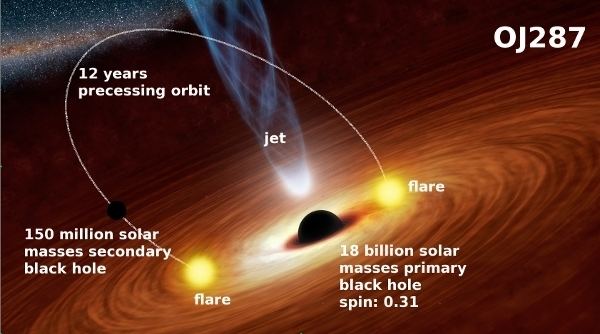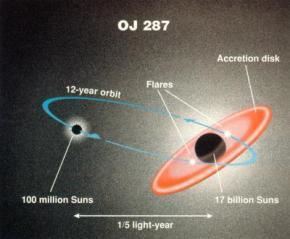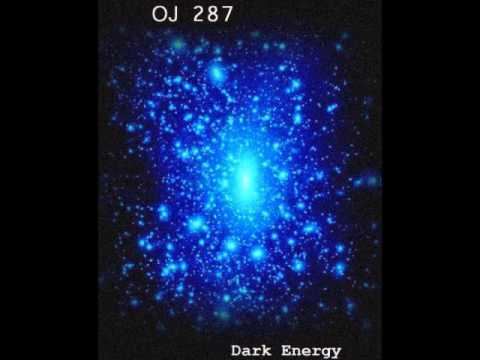Right ascension 08 54 48.9 Redshift 0.306000 Type BL Lac | Declination +20° 06′ 31″ Distance 3.5 Gly (1.073 Gpc) Magnitude 14.83 Apparent magnitude (V) 14.83 | |
 | ||
Similar BL Lacertae, 3C 66A, 3C 279, 3C 273, Markarian 421 | ||
Oj 287 eternal darkness ii 2014
OJ 287 is a BL Lac object located 3.5 billion light-years away that has produced quasi-periodic optical outbursts going back approximately 120 years, as first apparent on photographic plates from 1891. It has been seen on photographic plates since at least 1887. It was first detected at radio wavelengths during the course of the Ohio Sky Survey.
Contents

Oj 287 great attractor 2015
Characteristics

Its central supermassive black hole is among the largest known, with a mass of 18 billion solar masses, more than six times the value calculated for the previous largest object.

The optical light curve shows that OJ 287 has a periodic variation of 11–12 years with a narrow double peak at maximum brightness. This kind of variation suggests that it is a binary supermassive black hole of two black holes of similar size. The double-burst variability is thought to result from the smaller black hole punching through the accretion disc of the larger black hole every 12 years. Until the 2015 discovery of the binary nature of PG 1302-102, this was the best binary black hole candidate known, since 2008.

The smaller supermassive black hole with a mass of "only" 100 million MSun orbits the larger one with an observed 11- to 12-year orbital period. The maximum brightness is obtained when the minor component moves through the accretion disk of the supermassive component at perinigricon.
The mass was calculated in 2008 by a team led by Mauri Valtonen of Tuorla Observatory in Finland. The timing of these outbursts allows the precession of the companion's elliptical orbit to be measured (39° per orbit), which allows the mass of the central black hole to be calculated using Albert Einstein's principles of General relativity (see Kepler problem in general relativity).
The accuracy of this measurement has been called into question due to the limited number and precision of observed companion orbits, but the calculated value will be further refined using future measurements. The companion's orbit is decaying via the emission of gravitational radiation and it is expected to merge with the central black hole within approximately 10,000 years.
In order to reproduce all the known outbursts, a recent study shows that the rotation of the primary black hole has to be 28% of the maximum allowed rotation for a Kerr black hole.
